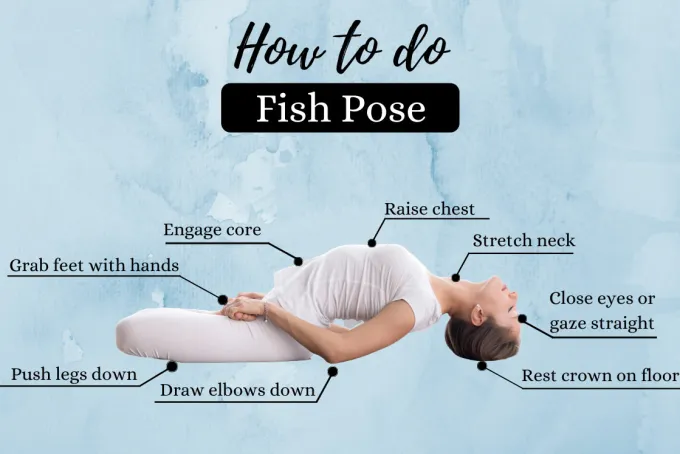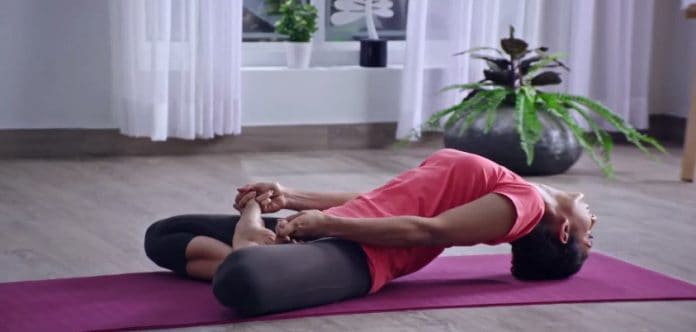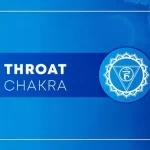Matsyasana or fish pose is a basic back-to-back tilt. In this asana, the entire upper part of your body is stretched out, which also makes it more flexible. It helps to improve the posture of your whole body.
The following muscles are the primary emphasis of this pose.
- Lower and middle back
- Core (abs) and hips
- Chest
- Neck and shoulders
| Sanskrit Pronunciation | mat-see-AHS-ah-nah, (Matsyāsana) मत्स्यासन |
| Meaning | Matsya – fish Asana – Pose |
| Pose Type | Sitting, reclining, back-bend |
| Pose Level | Beginner, practice 30 to 60 seconds |
| Beneficial In | Strength and flexibility in the core, back, and neck |
Origin and Philosophy
The 17th-century description of Matsyasana in the ancient yoga literature Gheranda Samhita confirms its medieval origins.
Additionally, this asana is explained by Swami Satyanand Saraswati and BKS Iyengar in their yoga sequences. This posture is the fifth of Hatha Yoga’s 12 fundamental positions.
When you practice Fish Pose in water, it’s claimed to make you float like a fish (Matasya). We refer to it as Fish Pose/Matasyasana for this reason.
According to BKS Iyengar, Matsyasana is devoted to the fish-like manifestation of Lord Vishnu. According to myth, Manu and seven great sages (Saptrishi) along with all of the Vedas were spared by the fish embodiment from the approaching universal floor, which was about to wipe out the entire world. So, he kept all of the knowledge.
Matsyasana How to Do Fish Pose

This pose is simple to perform. All that is required is good body synchronization and attentiveness. The stages to successfully performing Matsyasana are as follows.
Preparing the Asana
- First, place your hands on your sides, palms facing down while lying flat on your back on the floor.
2. Cross your legs in Padmasana right now (Lotus Pose). Next, lay your arms by your sides on the ground with the palms of your hands facing down.
Here, take a deep breath.
Getting Into the Asana
3. As much as you can, lower your legs toward the floor while exhaling. Arc your back and lift your chest and neck off the floor at the same time, using your arms and elbows as support.
4. Turn the head back and rest the crown of your head on the floor.
5. Hold the feet and try to bring the elbows to the floor, increasing the arch of the back.
Hold this position for 30-60 seconds with deep breaths. Either close your eyes or gaze straight.
Checkpoint
- The spine should be stretched.
- The crown of the head should be resting on the floor.
- Your chest should be raised, and the neck should be stretched.
Releasing the Pose Matsyasana
6. After finishing, inhale deeply. Exhale, let the arch go and lay flat on your back with your head on the floor for support.
7. Or, sit in padmasana, release the legs, and relax while taking a breath.
Recross the legs in the opposite direction and go through the motions again.
Additional Step
After step 5, BKS Iyengar describes an additional step. What he says is as follows:
After completing step 5, flex your arms and hold both elbows in place with the palm of your opposite hand. After that, place the forearms behind the head on the ground.
Modification
You can try the pose with straight legs if you are having problems holding your legs in Padmasana (Lotus Pose). In this position, you must keep your legs straight and stretched out while putting your forearms on the ground. The rest of the body is still in the same position as before.
Beginner’s Tips
- You may initially find the aforementioned stance a little difficult to execute. So, you can perform it while lying flat on your back and raising your arms overhead.
- You can put a yoga block beneath your crown if you are having trouble touching your head’s crown to the ground. Additionally, you can leave the crown dangling if you feel comfortable doing so.
- A smart solution is to place a rolled-up blanket beneath your back. Your back will be supported by it.
- You are welcome to seek assistance from a friend or teacher to do this pose correctly.
Precautions and Contraindications
- Don’t exert too much pressure on your head’s crown. On the ground, gently rest it.
- Avoid overextending your body. Stretch your body as far as it will allow.
- Only practice the Fish Pose on an empty stomach or at least 4 hours after eating.
- Don’t strain your neck in any way. Keep it in the spine’s natural arch.
- Those who have spondylitis should stay away from this pose (inflammation of the vertebra). This pose might be dangerous to practice since it puts strain on your neck and spine.
- Before attempting Matsyasana, check with your doctor if you suffer from high blood pressure, migraines, or heart issues. In these circumstances, it is best to stay away from this pose.
- Avoid this pose at all costs if you have a deep or recent injury to your neck, elbows, core, or spine.
- Pregnant women should avoid this pose since it exerts pressure on the area around the abdomen.
Benefits of Fish Pos
- Regular use of this pose improves the upper body’s overall flexibility. It helps to maintain the spine’s flexibility and strength. These are some advantages of practicing Matsyasana.
- This pose nourishes the pituitary and pineal glands and ensures proper blood flow to the head and brain. As a result, it enhances bodily and mental processes and lessens stress, anxiety, and depression.
- The neck and shoulder muscles and bones are strengthened through Matsyasana. This pose helps shoulder and neck alignment while also releasing tight muscles. Additionally, it helps to improve the round shoulders.
- It strengthens the neck and shoulders by releasing stress and stiffness.
- This pose is effective for opening the chest. It enhances lung capacity and opens up the chest. As a result, it promotes proper breathing and prana flow, and guards against respiratory illnesses.
- In the fish pose, the thyroid and parathyroid glands are gently stretched and massaged (responsible for metabolism and calcium levels). Thus, this asana aids in controlling calcium levels and metabolism within the body.
- It massages the abdominal organs and glands, including the liver, kidneys, intestines, etc., by gently stretching the area of the abdomen. As a result, it calms our digestive systems and provides relief from indigestion, constipation, and other digestion-related issues.
- The lower and middle back, pelvis, and hip flexors all receive a modest stretch with Matsyasana. As a result, it not only promotes a strong and flexible spine but also helps to reduce menstrual pain.
- This asana relaxes the brain and eliminates its restlessness. Additionally, this pose enhances sleep quality and aids in the fight against insomnia.
- Fish Pose helps to stimulate the Heart Chakra and throat (Visuddha) Chakra. Thus, it improves self-expression, self-belief, and emotional growth.





















